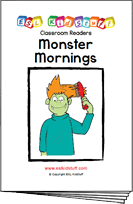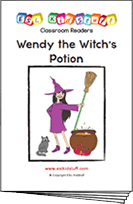Daily routines & Times of the day lesson plan
Stand-alone lesson ESL kids lesson plan
Lesson plans for ESL kids teachers

Daily routines & Times of the day
In this lesson students practice using the present simple tense to talk about daily routines and different times of the day. Students practice describing what they do on school days, play fun games and activities and take a class survey.
Members get accompanying flashcards, worksheets and classroom reader.
Download materials:
Our lesson plans are FREE!
Sign up for accompanying:
✔ worksheets
✔ homework sheets
✔ craft sheets
✔ flashcards
✔ song downloads & videos
✔ classroom readers & videos
Click to see lesson details, materials and supplies
Time: 40 mins – 1 hour
Objectives: Using the present simple tense to talk about daily routines and different times of the day.
Structures: “I … at (8 o’clock in the morning)”, “What time do you …?”, “When do you …?”
Target vocabulary: morning, afternoon, evening, night, wake up, get up, eat breakfast, eat lunch, eat dinner, go to school, start school, go home, arrive home, watch TV, do homework, go to bed.
Lesson materials
Flashcards:
- morning, afternoon, evening, night, wake up, get up, eat breakfast, eat lunch, eat dinner, go to school, start school, go home, arrive home, watch TV, do homework, go to bed.
Printables:
- What time do you …? (survey) worksheet
- My day 3 worksheet
- Reader worksheet
Readers:
- Tom’s cat
Additional materials:
- Daily routines vocab crossword
- Daily routines vocab word search
- Tom’s day
Supplies:
- [hide_on_uk]colored[/hide_on_uk][hide_on_us]coloured[/hide_on_us] pencils
- 5 cardboard boxes
- Blu-Tack or tape
- a clock with hands that can be moved (either real of a craft clock)
- board with marker / chalk
This lesson will be drawing on aspects studied in a couple of previous lessons, so make sure it is taught after the telling the time lesson and the morning routines lesson.
Answer: the present simple tense
When talking about everyday, habitual activities we use the present simple tense. This shows that these are things we do on a regular basis.
The present simple tense for daily routines is formed as follows:
- Use the present simple form of the verb, e.g. “I eat breakfast at 7 o’ clock.”
- Use “s” or “es” for 3rd person singular form (he, she, it), e.g. “He plays video games after school”, “She watches T.V. in the evening”
- For negatives, use the present simple form of the verb “do” as follows: do/does + not + infinitive without to, e.g. “I don’t do homework on Saturdays”, “She doesn’t drink tea in the morning”
- For questions, use the present simple form of the verb “do” as follows: do/does + subject + infinitive without to, e.g. “Do you play rugby on Tuesdays?”, “Does Maria eat lunch at school?”
Lesson procedure:
Warm up and maintenance:
The beginning of your lesson is extremely important: this is where you set the tone of your lesson and get everyone in the right frame of mind for learning English. It is also an opportunity to check homework and review previous lessons.
Click for warm up suggestions for the start of your lessons
These activities can be done in the following order at the start of your lesson:

1. Greetings and name tags
Greet the students by name as they enter the classroom and gesture for them to sit down. Before class prepare some blank name tags (stickers or pin-on tags). Give these out and have everyone write their names and put their tags on. If you use pin-on tags, you can keep and give out every class.

2. Homework check
Check each student’s homework set in the last lesson. Ask each student some questions about their homework worksheet (e.g. “what [hide_on_uk]color[/hide_on_uk][hide_on_us]colour[/hide_on_us] is it?”), give lots of praise, and then put some kind of mark on the homework sheet (e.g. a sticker, a stamp or draw a smiley face). Finally, tell your students to put their homework back into their bags.
3. Review past lessons
Reviewing past lessons is very important – students need constant practice of new vocab, structures, songs, games and so on. Always review parts of your last lesson as well as some parts from other previous lessons. You can spend 5-10 minutes reviewing – it’s fine to recycle games and activities from your past lessons to review as kids enjoy playing familiar games (although be careful not to play a game to death!). See the section “Other ideas to include in your warm” below for ideas.
You can also include review activities in the main body of your lesson. Kids can have short attention spans so it’s good to be able to pull out lots of activities during different stages of the lesson.
Other ideas to include in your warm up:
Ball pass questions
This is good to review questions from previous lessons. Get everybody standing in a circle.

Round 1:
Take a ball and hold it and say, “My name is (you name)”. Then throw the ball to one student and say, “What’s your name?”. Students throw the ball around randomly, saying their names and asking for names.
Round 2:
This time ask a review question, e.g. “How many tables are there?”. Then throw the ball to a student who should answer, “There are (6) tables”. Help if necessary. Then that student throws the ball to another student and asks a “How many …?” question. Continue so everyone has a go. You can have multiple rounds with different topic questions.

Play “Spin the bottle”
Sit students in a circle with a bottle in the middle. Teacher spins the bottle. When it stops spinning the student it is pointing to has to answer a question. If the answer is correct then that student can spin the bottle. This is a good class warm up activity (e.g. How are you? What’s your [hide_on_uk]favorite[/hide_on_uk][hide_on_us]favourite[/hide_on_us] food? How’s the weather today?, etc.

Play “Vocabulary basketball”
This is a fun game which reviews vocabulary from previous lessons. You will need a basket (a trash can) and 2 balls (or 2 pieces of A4 paper scrunched up into balls).
Form 2 teams and line them up so that two players from each team are facing the front with the basket in front of them. Let both players throw their ball – if they get their ball into the basket they can try and win a point by giving the correct answer to a question the teacher asks. This can be an actual question (e.g. What are you wearing?) or a flashcard (What’s this?). Then they go to the back of the line. At the end, the team with the most points is the winner!
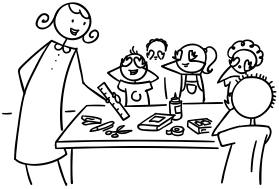
Play “What’s missing?”
This is a fun review memory game – students will have to try to remember review objects from previous lessons (e.g. classroom stationery). Lay the objects out on a table for all to see. Allow the students a minute to memorize the positions of the objects. Remove an object and hold it behind your back. Say, “Open your eyes!” – the first student who can shout out the missing object wins a point for his/her team. Play for all the objects.
Finally, calculate which team has won the most points and give them a round of applause.

Play “Quiz game show”
This is a fun quiz game, like a simple version of a TV game show. Draw some circles on the board and randomly write numbers 1, 2 or 3 in each circle. These will be points.
Put students into teams. Then ask the first team to choose a number – 1 is an easy question (e.g. “Do you like bananas?”) and 3 is a difficult question (e.g. point at a clock and ask, “What time is it?”). 2 will be in between in terms of difficulty. When the question has been answered correctly, erase that number circle. Play until all the number circles are gone – the team with the most points is the winner!

Read a classroom reader again
As you progress through the lessons you will start to build up a catalog of classroom readers (see our Readers download page at https://www.eslkidstuff.com). Kids love going back to old stories and reading through them again. Invite a student to pick a classroom reader and read through it as a class. Make the story as interactive as possible by asking questions (e.g. what [hide_on_uk]colors[/hide_on_uk][hide_on_us]colours[/hide_on_us] there are, the names of different objects, etc.) and getting students to speculate what is going to happen next in the story.

Talk about the weather (do after you have taught the weather lesson plan).
- Prepare a weather board. Before the first class prepare a piece of cardboard and cover it with felt – you are going to pin this to the wall. If you can, try and get blue felt (to represent the sky). Write at the top in large letters, “How’s the weather today?”. Below that write “Today it’s”. Cut out weather pictures (such as our weather flashcards) and stick some velcro on the back. Arrange the weather pictures around the edge of the board and then put the board on the wall of your classroom. You can now use this weather board at the beginning of every lesson.
- Ask about the weather. Ask, “How’s the weather today?” and have students put up their hands. Allow one weather condition per student (e.g. “It’s rainy”) and have each student come up and put a weather picture on the weather board.
- Introduce more weather vocabulary. Depending on weather conditions, you can introduce more weather words (with pictures … you can get students to draw them), such as:
- stormy
- misty
- showery
- freezing
- humid
- frosty
- icy
- drizzly
New learning and practice:
1. Introduce 4 times of the day: morning, afternoon, evening and night
Quickly introduce the 4 words by drawing a picture on the board:
- Draw a simple house with a tree next to it and a horizon.
- Then draw a sun just rising over the horizon. Teach/Elicit “morning” and chorus 3 times.

- Next, erase the sun and draw the sun high up in the sky and teach/elicit/chorus “afternoon”.
- Then draw the sun low in the sky on the other side of the house for “evening”.
- And finally a moon and stars for “night”.
Next erase the moon and starts and invite a student up to the board. Say, “Draw afternoon”. Help if necessary and have the student draw the sun high in the sky. Erase the sun and invite other students to draw the other times of the day.
2. Play “Times of the day boxes” game
You will need to prepare 5 cardboard boxes and print the flashcards for morning, afternoon, evening, night, wake up, get up, eat breakfast, eat lunch, eat dinner, go to school, start school, go home, arrive home, watch TV, do homework, go to bed. You can also add some other flashcards for daily routines, such as brush teeth, play video games, etc. The more flashcards, the better.
On 4 of the boxes, stick one of the morning, afternoon, evening and night flashcards on the outside of each and place in different corners of your classroom. In the remaining box put lots of small objects, e.g. balls, bean bags, blocks, etc. and place in the middle of the classroom.
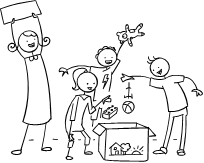
Model the activity: hold up one of the flashcards (e.g. “get up”) – say the word “get up”. Then pick up an object from the object box and point to the 4 boxes around the room. Ask “Which one?” and then go and drop the object into the morning box. Say “morning” as you drop the object into the box.
Now let’s start the game. Hold up a flashcard (any from the daily routines set) and shout out the verb (e.g. eat dinner). Get everyone to come up together, pick up an object and drop it in the correct box (make sure they say the time of the day word as they drop). Then proceed through all of the flashcards quickly as students rush around the classroom putting objects into the correct boxes. It may be the case that some students will need to visit two boxes for some activities (e.g. watch TV could be morning and evening) – this is fine.
Finally, ask everyone to guess which box has the most objects – then count out the objects in each box to see which is the winning time of the day!
3. Create a “Times of the day” chart on the board
If you don’t have a board, you can use a large sheet of paper stuck to your wall. Draw a vertical and horizontal line to create 4 equal squares and title each square with “in the morning”, “in the afternoon”, “in the evening” and “at night” (see image below).
Have your students copy the chart into their notebooks or onto a sheet of paper.
Next, your students are going to stick the daily routines flashcards onto the board. First model: take a random flashcard and show it to the class. Elicit the word (e.g. “wake up”) and stick it into the “in the morning” section of your board. Write “I wake up” next to it. Have your students write “I wake up” into the corresponding square on their charts.

Then have different students come up to you and select a card (hold face down, fanned out, like a card trick). Have them stick the cards onto the board in the right section. For more advanced students you can help them write each sentence, otherwise the teacher can write the sentences next to the cards. Each time, have students copy onto their charts. Continue until all of the cards are on the board with sentences:

4. Add times to the “Times of the day” chart”
Your students will have studied telling the time in a previous lesson (see our Telling the time lesson plan). We are going to add times to the chart.
Again, first model: point to “I wake up” on the chart. Do the gesture for waking up (stretching, yawning, rubbing eyes) and then look at your watch. If you have a clock (either real or a craft clock – we have a great clock craft sheet on our crafts page) you can hold this up. Set the time to 11:00 and say “I wake up … at 11 o’clock?”. Make sure everyone says, “Noooo!”. Then ask someone to move the clock hands to a more realistic time, such as 7:00. Write on the board, “at 7 o’clock” after “I wake up”. Chorus, “I wake up at 7 o’clock in the morning”. Get everyone to write the time that they wake up on their chart
Now have students come up to you, change the time on your clock and write times on the board next to each flashcard (e.g. I eat lunch at 12 o’clock in the afternoon), and make sure these are being chorused and times are being written on the students’ charts.
NOTE: For times that are not hourly (e.g. 6.30, 9.55, etc.) you need to decide whether to teach the full times (e.g. half past six, five to ten) or the digital version (six thirty, nine fifty-five).
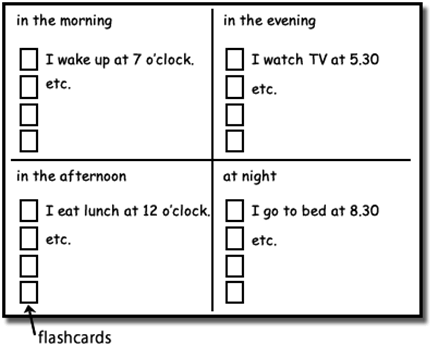
5. Play the “Daily routines memory game”
Erase the chart from the board and take off the flashcards. Put students in pairs and get them to swap charts. Students are going to test each other on the times they do things.
Make sure you model with 2 students first:
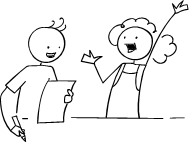
Student A: selects a sentence on Student B’s worksheet (e.g. I do homework at 6 o’clock). S/He does the action of doing homework (e.g. writing in an imaginary notebook).
Student B: must guess the action and say the exact sentence on their chart (e.g. “I do homework at 6 o’clock in the evening”).
Then it is student B’s turn to select a sentence and do the action. Pairs keep going until they have done all of the sentences on their charts. Make sure students don’t allow their partners to get away with mistakes – if they get the time wrong, make them guess again!
6. Do the “What time do you …? (survey)” exercise
Give each student the survey worksheet and explain that they are going to ask 6 people in the class (or less, depending on class size) about their daily routines on school days. Before starting, go through the survey sheet with everyone and make sure they write an additional activity on the last row. Then model with a student, showing writing their name at the top of the column and asking and answering questions using the following structure:
Student A: What time do you (wake up)?
Student B: I (wake up) at (7 o’clock) (in the morning).
Have students stand up and mingle, filling in their surveys.

7. Daily routines theater
Now let’s do a fun activity – your students will make a short theater play! Pair up students but make sure each pair has surveyed the other in the previous activity. They are going to use their survey sheets to make a short play.
For each pair, one student will act out their day whilst the other is the narrator (using the survey to make the narration). Give each pair 5 minutes to practice before coming up to the front of the class and acting out their daily routines, for example:
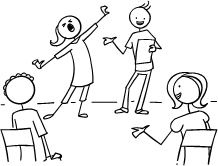
Ken (narrating): Hello, my name is Erika!
Erika: (waves to audience)
Ken: I wake up at 7 o’clock in the morning.
Erika: (Pretends to sleep, wake up, stretch and yawn, etc.)
Ken: I eat breakfast at 7:30 in the morning.
Erika: (Pretends to eat cereal, drink juice, etc.)
etc.
Encourage students to make their plays funny and also allow them to add extra parts (e.g. play video games, read a book, ride a bike, etc.).
At the end, get everyone to vote for their [hide_on_uk]favorite[/hide_on_uk][hide_on_us]favourite[/hide_on_us] play.
8. Read classroom reader “Tom’s cat”
Let’s end with a nice story which reinforces the lesson vocab and structures. Before class, download and print off the reader “Tom’s cat”. As you go through each page, point to the pictures, elicit each routine action, elicit times on the clocks and times of the day and ask if your students do those things at that time or time of day, for example:
Teacher: What time is it? (pointing at the alarm clock on page 3)
Students: 8 o’clock!
Teacher: Yes, 8 o’clock! At night?
Students: No, in the morning!
Teacher: And what does Tom’s cat do at 8 o’clock in the morning?
Students: He sleeps!
Teacher: Yes, how about you Hugo? Do you sleep at 8 o’clock in the morning?
Student (Hugo): No, I don’t.
Teacher: Look at Tom. What does he do at 8 o’clock in the morning?
Students: He wakes up!
Teacher: That’s right! And what does he do next?
Students: He eats his breakfast and brushes his teeth …
etc.
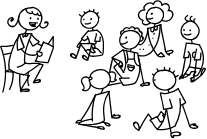
Get the students really involved in the story by asking lots of questions and getting them to tell you about their daily routines.
After reading the story, give out a reader worksheet to each student and read through the story one more time (without stopping for questions, etc.) as students fill in the missing verbs and write the times. Then go through the answers as a class.
Alternatively, watch our video version of the reader (Internet connection required).
Wrap up:
Assign homework: “My day 3” worksheet
Click for wrap up suggestions for the end of your lessons

1. Assign homework
Each week give out a homework worksheet for your students to take home. Hold up the homework worksheet and model how to do it. Give out the worksheets and say, “Put your homework in your bags”.

2. Do “Quick check”
Time to leave the class. Make sure everything is put away and the students have gathered their belongings. Have them line up at the door and place yourself between the door and the students. For each student check one new word or phrase, for example:
- hold up an object or flashcard (such as an item of clothing) and ask, “What’s this?”
- ask a question from the lesson (e.g. “Where do you live?”, “Do you like bananas?”, “Can you play chess?”, etc.)
When they give you the correct answer say goodbye and let them leave. If their answer is wrong, have them go back to the end of the line – they will have to try again once they reach the front!
Other lesson plans
Actions, verbs & tenses:
- Can – for ability
- Morning routines
- Daily routines & times of the day
- Actions – Present continuous
- Future plans using “going to”
- Past tense activities – Regular verbs
- Past tense activities – Irregular verbs: Part 1
- Past tense activities – Irregular verbs: Part 2
Adjectives:
- Describing people
- Describing things
- Comparing things (Comparative adjectives)
- Comparing things (Superlative adjectives)
Adverbs:
Alphabet:
Animals:
Body:
Classroom:
Clothes:
Colors:
Colours:
Directions:
Family:
Feelings & emotions:
Food:
Health & sickness:
Holidays & festivals:
Jobs:
Likes, dislikes & favorites:
Likes, dislikes & favourites:
- Likes & dislikes
- [hide_on_uk]Favorites[/hide_on_uk][hide_on_us]Favourites[/hide_on_us] and asking why
Nature & Our world:
Numbers:
Places & where we live:
Prepositions of location:
Pronouns:
Shapes:
Shopping:
Sports:
Time, days, months, seasons:
Toys:
Transport & travel:
Weather:




